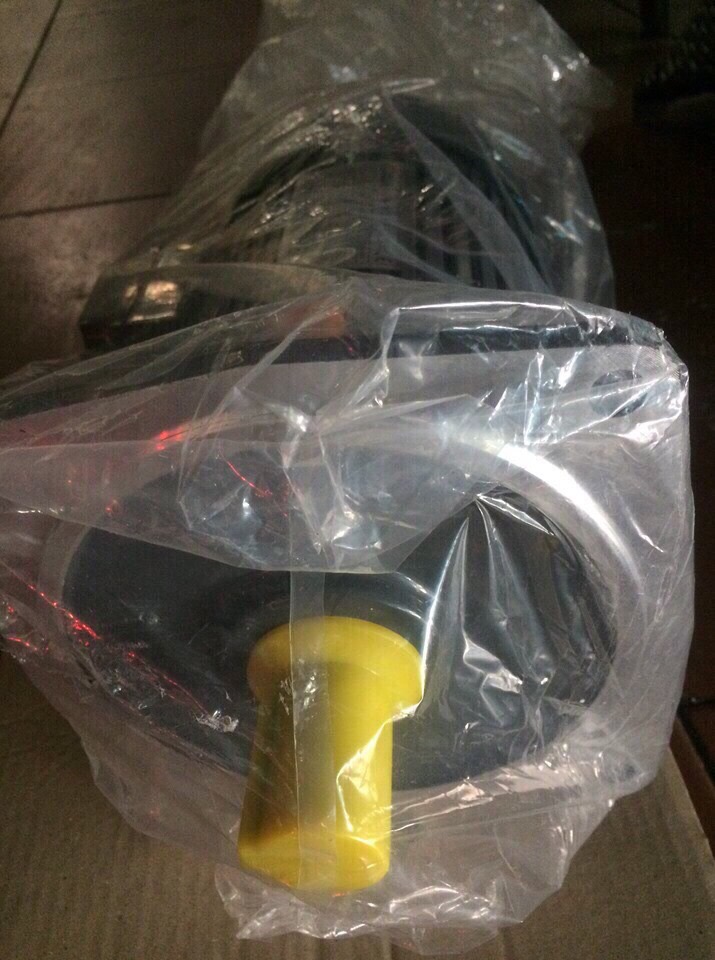- Home
- /
- News
- /
- Industry News
Speed reducers get the shaft

The next time your drive calls for a geared speed reducer, take a look at the shaft-mounted types. They offer a compact, low cost, easy-toapply alternative to foot-mounted reducers
When it comes to selecting a speed reducer, most engineers think of the foot-mounted type that connects between the drive motor and driven machine via coupled shafts. But many applications including those in the grain, aggregate, and bulk material handling industries are better suited to a shaft-mounted speed reducer. This type mounts on the input shaft of a driven machine, and is held steady by an adjustable arm attached to the machine housing.
It offers several advantages over foot-mounted parallel-shaft reducers including lower installed cost, smaller size, and elimination of alignment requirements. A shaft-mounted reducer, installed with motor mount, tapered bushings, V-belt drive, and belt guard, can save as much as 40% of the cost of a foot-mounted reducer.
The reducer can be mounted in horizontal, vertical or inclined positions. In most cases, it is horizontal. The drive motor attaches to the top of the reducer housing with a motor mount, and it drives the reducer with a V-belt.
Because the motor and V-belt drive mount directly on the reducer, shaft-mounted reducer assemblies require less space than foot-mounted ones with coupled shafts. Further, the motor-belt-reducer assembly can be mounted directly onto the input shaft of the driven machine and secured by either straight or tapered bushings.
These bushings are concentrically machined to eliminate any misalignment between the reducer bore and the input shaft of the driven machine. Moreover, directly connecting the components eliminates alignment variations due to separate shafts and couplings, thereby reducing installation time and expense. Bushings allow easy installation and removal, and avoid the need to realign the reducer during re-installation. They can accommodate shafts up to 10-in. diameter.
Shaft mounted reducers generally range from fractional to 750 hp, with speed-reduction ratios from about 5:1 to 25:1 and output speeds from 1 to 400 rpm. Most of them contain helical gears, which have higher load capacity than spur gears because their angular tooth orientation produces a longer effective tooth width. Others have spur or herringbone gears.
In addition to tapered or straight bushings for mounting, units may come with backstops, cooling fans, and auxiliary seals.
Choosing size
Shaft-mounted reducers are classified as Class I, II or III, with corresponding Service Factors (SF) of 1.0, 1.4, and 2.0 respectively.
Class I reducers operate under steady loads 10 hours or less per day. They are not subjected to heavy shock but may experience light shock loads on a limited basis. Normal running conditions do not cause loads that exceed rated motor horsepower. The maximum starting load or momentary load must not exceed 200% of the horsepower rating. If it does, then you need to use the larger horsepower rating for selecting the reducer.
For example, assume that a drive with a 5-hp motor will run less than 10 hours a day. This drive would normally operate within the parameters of a Class I reducer. However, shock loads boost the maximum horsepower requirement to 12.98 hp. This exceeds the 200% rating of the motor (2 x 5 hp = 10 hp). Therefore, you must use a higher motor horsepower requirement, 12.98 hp/2.0 = 6.49 hp, for sizing the reducer.
Class II reducers operate over 10 hours per day under steady or moderate shock loads. Starting loads or peak loads are not to exceed 280% of the maximum motor rating. If the maximum horsepower rating is exceeded, use the same procedure as before, but divide the calculated horsepower by 2.8 instead of 2.0.
Class III reducers operate over 10 hours a day, experience moderate shock loads, and may encounter heavy shock loads for up to 10 hours a day. Starting loads or momentary loads must not exceed 400% of the motor rating. If they do, use the same procedure as before, but divide the calculated horsepower by 4.
Suppose a belt conveyor driven by a 5-hp motor that operates 10 hours or more per day with a non-uniformly applied load requires a Class II reducer. Multiplying the motor rating (5 hp) by the Class II Service Factor (1.4) gives the required horsepower rating for the reducer (7 hp). The torque, based on the required horsepower rating and reducer output speed, is found from the formula:
T = (63,025 x HP)/N
where:
T = Torque, lb-in.
HP = Required horsepower rating, hp (includes service factor)
N = Shaft speed, rpm
Once the torque and horsepower ratings are determined, you can choose a suitable reducer from the manufacturer’s catalog.
Next, calculate the overhung load on the reducer input shaft due to the belt drive and compare it to the specifications of the chosen reducer. The overhung load is:
OHL = (63,025 x HP x F)/(N x R)
where:
OHL = Overhung load, lb
F = Input drive factor, 1.5 for Vbelt. Other values are 1.0 for single chain, 1.25 for spur and helical gear and double chain, 1.3 for timing belt, and 2.5 for flat belt.
R = Pitch radius of sprocket or sheave on reducer input shaft, in.
Next, make sure the maximum bore diameter of the reducer is large enough to accommodate the input shaft of the driven machine.
Most catalogs for shaft-mounted reducers contain charts and tables that summarize the results of these calculations. Such tables are typically based on the class of service, input speed, horsepower requirement, and the output speed at which the reducer is to be operated. After choosing the table that is based on your Service Factor, select a reducer that provides the required horsepower and output speed.
These tables eliminate the need to calculate overhung load: they simply list the minimum sheave diameter that can be used so as not to exceed the overhung load limits of the reducer.
In the previous examples, we assumed that the horsepower requirements were known. But what if the horsepower requirements are not known? Consider an inclined belt conveyor 300 ft long with a rise of 20 ft. The belt must move 300 tons/hr from its low end to the opposite end.
The manufacturer’s catalog shows that it requires 8.4 hp to move 300 tons/hr along a horizontal plane and 6 hp to lift the load to 20 ft. Adding these two figures gives the total horsepower required to move the load to the other end of the conveyor, which is 14.4 hp, or rounded up to 15 hp.
Using the manufacturer’s selection tables, choose a reducer that provides the required horsepower and desired speed. Then use the V-belt drive section of the catalog to find the sheave diameters and the number of belts required.
In this example, you can select any reducer output speed listed. However, you must also choose a conveyor belt width that, in combination with the reducer speed, will deliver the required 300 tons/hr.
Estimated life
The expected life of a speed reducer usually depends on the L10 life of its bearings. ANSI/AGMA standard 6021-G89 recommends that reducer bearings provide at least 5,000 hr L10 life for Class I service as calculated from the equations:
L10 life = 5,000 (SF)3.3 for roller bearings
L10 life = 5,000 (SF)3.0 for ball bearings
[Speed reducer life depends on the type of bearings it contains and the application Service Factor.]
where SF = Service Factor.
Some manufacturers, however, base the bearing life on something less then 5,000 hr, which results in a lower calculated life. Let’s examine an L10 life of 5,000 hr compared to one of 3,000 hr. Assume both reducers have a service factor of 2.0 and are equipped with tapered roller bearings.
With the normal L10 life based on 5,000 hr, the reducer has an average estimated life of about 50,000 hr (see curve), whereas an L10 life based on 3,000 hr gives the reducer only about 29,500 hr life (manufacturer’s curve not shown). This is a 40% reduction in service life and shows clearly the need to carefully evaluate bearing ratings when choosing a reducer to fit your application.
Avoiding slippery problems
To ensure satisfactory reducer performance, address lubrication requirements early in the design phase. Select the correct ISO grade oil for the ambient operating conditions per the manufacturer’s instructions. Also make sure that oil levels are easy to maintain. Low oil levels can damage bearings and gears; whereas high oil levels can lead to overheating due to air trapped in the oil.
Lubrication is particularly important where a backstop is used. A backstop lets the reducer turn freely in one direction but locks up when reversed. This is required on applications such as belt conveyors or bucket elevators to prevent injury if electrical power to the motor is interrupted. If the reducer has a backstop, don’t use oils with EP additives such as graphite or molybdenum disulfide. They will cause excessive slippage of the sprag action of the backstop.
Contamination due to poor shaft sealing can also be a major contributor to reducer failure. As the reducer operates, dirt and grit around the input and output shafts is ground into the seal areas, damaging the seals and shafts, and causing leaks. Auxiliary and harsh duty seals are available that provide extra protection to seal out contamination.
The type of breather used in the oil reservoir also affects contamination. Standard breathers allow contaminants to be sucked into the reducer where they can cause bearing, gear, and seal damage An improved filter breather or a sealed bladder breather will prevent this from happening.
Key: Horizontal Inverter duty, Vertical Inverter Duty motor, DC Brake motor Oil Pressure Motor, Small Gear motor-Horizontal Type Ac Gear Motor, Small Gear motor-Vertical Type Ac Gear Motor, Helical Gears High Gear Ratio, Vertical Gear box High Gear Ratio, Horizontal double shaft motor, Vertical double shaft motor, Horizontal Flanged Gear reducer, CNC machine, AC mini Induction DC gear motor, Vertical Flanged Gear reducer, Horizontal Type Light load Gear motor, Vertical Type Light Load Gear motor, Horizontal Type Large Dc Motor, Horizontal Flanged Large Geared motor, Vertical Type Large Dc motor, Worm Gear Reducer, NMRV/NRV Worm Gear reducer, Horizontal reduction gear for electric motor, Vertical Cast iron Induction Motor, Horizontal 3 Phase ac induction motors, High Purity aluminium foil sheet Hairdressing Foil High Quality A, High Durability 3 phase ac induction motor, High Speed light weight ac induction motor
Newer articles
- Helical gears or spur gears? (05/09/2018)
- Three-Phase Induction Motor Torque-Speed Characteristics (12/09/2018)
- Why are DC motors usually gear motors? (19/09/2018)
- Gearmotor Selection: Price is Important, But Not Everything ... (20/09/2018)
- The benefits of gearboxes and when to pick integrated gearmotors (05/09/2018)
- What are the benefits of using gear motors? (05/09/2018)
- How to Select a Gearmotors (01/10/2019)
- What is a DC Motor? (03/06/2019)
- INSTRUCTIONS FOR GEAR REDUCER MOTOR (01/12/2018)
- What are Brushless DC Motors (31/05/2019)
Older articles
- Basic Structure Of Gear Motor Reducer (07/07/2018)
- What are characteristics of planetary gearmotors? (08/08/2018)
- Checking phase sequence of 3 phase supply (14/08/2018)
- Motors and Drives: AC or DC? (14/08/2018)
- Causes of faults in electric motors and their effects (14/08/2018)
- Why electric motors fail (13/08/2018)
- What is the difference between a squirrel cage motor and a wound-rotor (slipring) induction motor? (13/08/2018)
- Follow instructions to use the speed reducer motor (12/08/2018)
- What are Features, Benefits and Use of Gear Boxes and Geared Motors? (02/08/2018)
- Design Considerations for Gearmotor Applications (26/07/2018)





Join